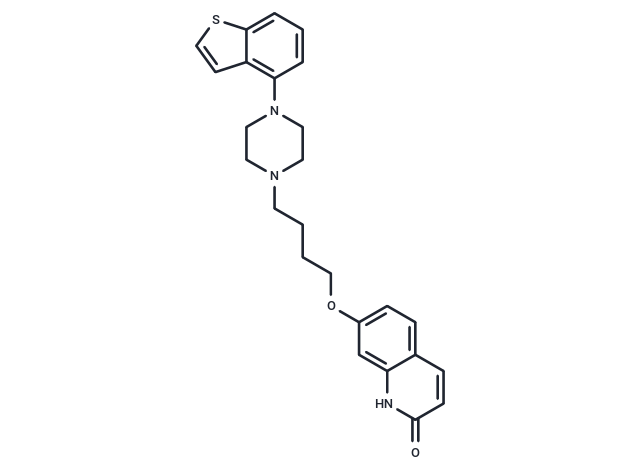Shopping Cart
Remove All Your shopping cart is currently empty
Your shopping cart is currently empty
Brexpiprazole (OPC-34712) is a partial agonist of human 5-hydroxytryptamine (5-HT) 5-HT1A and dopamine D2 receptors.

| Pack Size | Price | USA Warehouse | Global Warehouse | Quantity |
|---|---|---|---|---|
| 5 mg | $45 | In Stock | In Stock | |
| 10 mg | $61 | In Stock | In Stock | |
| 25 mg | $73 | In Stock | In Stock | |
| 50 mg | $85 | In Stock | In Stock | |
| 100 mg | $101 | In Stock | In Stock | |
| 200 mg | $150 | In Stock | In Stock | |
| 500 mg | $288 | In Stock | In Stock | |
| 1 mL x 10 mM (in DMSO) | $50 | In Stock | In Stock |
| Description | Brexpiprazole (OPC-34712) is a partial agonist of human 5-hydroxytryptamine (5-HT) 5-HT1A and dopamine D2 receptors. |
| Targets&IC50 | α2C-adrenoceptor:0.59 nM(Ki), D2L:0.3 nM(Ki), 5-HT1A:0.12 nM(Ki), Noradrenaline α1B (human):0.17 nM(Ki), 5-HT2A receptor:0.47 nM(Ki) |
| In vitro | Brexpiprazole is a potent partial agonist at human 5-hydroxytryptamine (5-HT) 5-HT1A (Ki=0.12 nM) and dopamine D2L (Ki=0.3 nM) receptors, and an antagonist at 5-HT2A receptors (Ki=0.47 nM). It also shows potent antagonist activity at human noradrenergic α1B (Ki=0.17 nM) and α2Creceptors (Ki=0.59 nM). Furthermore, this drug displays moderate affinity for human D3, 5-HT2B and 5-HT7 receptors, as well as α1A, and α1D adrenergic receptors. Brexpiprazole potentiated NGF-induced neurite outgrowth in PC12 cells. It could significantly potentiate the effects of fluoxetine (or paroxetine) on neurite outgrowth[1]. |
| In vivo | Brexpiprazole is able to ameliorate PCP- 191 induced cognitive deficits in mice, via 5-HT1A receptors[2]. |
| Cell Research | 2.5 ng/ml of NGF(nerve growth factor) is used to study the potentiating effects of brexpiprazole on neurite outgrowth. Twenty-four hours after plating, the medium is replaced with DMEM medium containing 0.5% FBS and 1% penicillin-streptomycin with NGF (2.5 ng/ml), with or without brexpiprazole (0.001, 0.01, 0.1 or 1.0 μM). Four days after incubation with NGF (2.5 ng/ml) with or without drugs, morphometric analysis is performed on digitized images of live cells taken under phase-contrast illumination, with an inverted microscope linked to a camera. (Only for Reference) |
| Synonyms | OPC-34712 |
| Molecular Weight | 433.57 |
| Formula | C25H27N3O2S |
| Cas No. | 913611-97-9 |
| Smiles | C(CCCOC=1C=C2C(=CC1)C=CC(=O)N2)N3CCN(C4=C5C(SC=C5)=CC=C4)CC3 |
| Relative Density. | 1.245 g/cm3 (Predicted) |
| Storage | Powder: -20°C for 3 years | In solvent: -80°C for 1 year | Shipping with blue ice/Shipping at ambient temperature. | |||||||||||||||||||||||||
| Solubility Information | H2O: < 1 mg/mL (insoluble or slightly soluble) DMSO: 21 mg/mL (48.44 mM), Sonication is recommended. Ethanol: < 1 mg/mL (insoluble or slightly soluble) | |||||||||||||||||||||||||
Solution Preparation Table | ||||||||||||||||||||||||||
DMSO
| ||||||||||||||||||||||||||
| Size | Quantity | Unit Price | Amount | Operation |
|---|

Copyright © 2015-2026 TargetMol Chemicals Inc. All Rights Reserved.